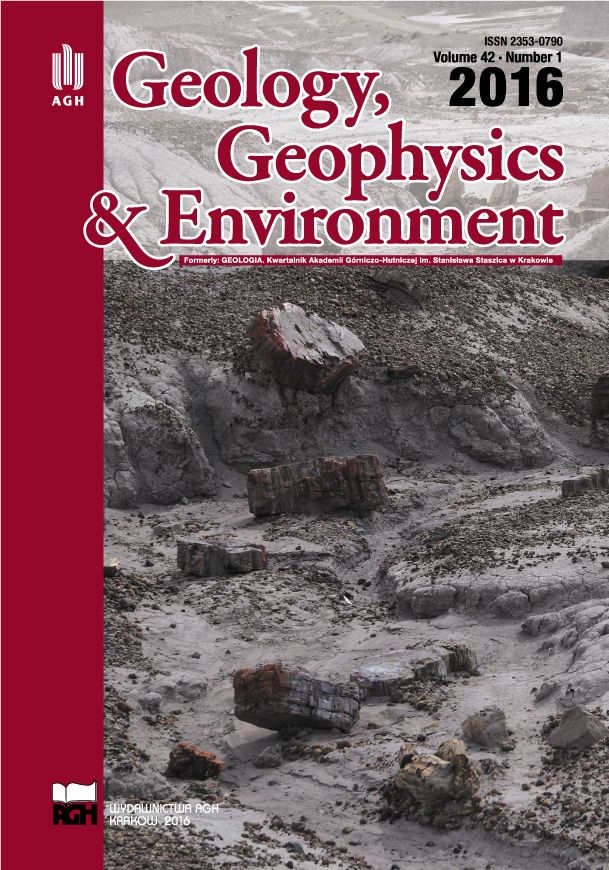Characteristics of soil of “Józefka” deposit overlay, Kielce District
DOI:
https://doi.org/10.7494/geol.2016.42.1.116Keywords:
Analiza DTA, skład mineralogiczny, parametry fizyczne gruntu, JózefkaAbstract
The area of research works comprised the mining area of the Józefka mine, located in Górno – ca. 10 km eastwards from Kielce. Dolomite and calcareous deposit is exploited in the mine. It is estimated that it dates back to Givetian period (Czarnocki 1938). The obtained material is used as road aggregate. The deposit is located in the southern part of Świętokrzyskie Mountains, in the so-called Kielce zone being the component of Małopolskie Province Massif (Stupnicka 1997). Silty soils deposited in the bed were pocket and interbedding. An attempt to describe them precisely has not been taken up yet.
Three samples with intact structure, natural moisture and graining were collected during field works. The deposit recognition was carried out at two stages:
1) mineral and petrographic,
2) geotechnical.
In the first stage analysis includes optical microscopy of thin section, X-ray diffractometry and thermal differential analysis DTA. Clay fraction (below 2 µm) was separated by settling in water. Oriented specimens, glikoled and heated to 550 oC were analyzed. The rock contains up to 70 wt% of detrital quartz.
At the second stage the research programme in accordance with the engineering practice and discipline standards was adopted (PKN-CEN ISO/TS 17892 and guidelines Building Research Institute). Basic physical parameters were designated:
– natural moisture,
– bulk density,
– density,
– granulometric composition,
– plasticity and liquidity limits,
– swelling index.
Based on granulometric composition the tested soils were classified (as per PN-EN ISO 14688-2 standard) as silt clayey-sandy (saclSi). The results of swelling index designation classify sample 1 as highly swelling and the remaining ones as medium swelling (Niedzielski, 1993).
The purpose of the project was to indicate the dependency between the diversification of mineral composition and physical properties of tested material.
Downloads
References
Czarnocki J., 1938. Ogólna mapa geologiczna Polski. Arkusz 4 – Kielce. Wydanie PIG, Warszawa (in Polish).
Niedzielski A., 1993. Czynniki kształtujące ciśnienie pęcznienia oraz swobodne pęcznienie iłów poznańskich i warwowych. Roczn. AR w Poznaniu. Rozpr. Nauk., 238.
CEN ISO/TS 17892-1:2009 – Badania geotechniczne. Badania laboratoryjne gruntów. Część 1 – Oznaczanie wilgotności.
PKN-CEN ISO/TS 17892-12:2009 – Badania geotechniczne. Badania laboratoryjne gruntów. Część 12 – Oznaczanie granic Atterberga.
PKN-CEN ISO/TS 17892-2:2009 – Badania geotechniczne. Badania laboratoryjne gruntów. Część 2 – Oznaczanie gęstości gruntów drobnoziarnistych.
PKN-CEN ISO/TS 17892-3:2009 – Badania geotechniczne. Badania laboratoryjne gruntów. Część 3 – Oznaczanie gęstości właściwej – Metoda piknometru.
PKN-CEN ISO/TS 17892-4:2009 – Badania geotechniczne. Badania laboratoryjne gruntów. Część 4 – Oznaczanie składu granulometrycznego.
PN-EN ISO 14688-2 – Badania geotechniczne. Oznaczanie i klasyfikacja gruntów. Część 2: Zasady klasyfikowania.
Stupnicka E., 1997. Geologia regionalna Polski. Wyd. Uniwersytetu Warszawskiego, Warszawa (in Polish).
Downloads
Published
Issue
Section
License
Authors have full copyright and property rights to their work. Their copyrights to store the work, duplicate it in printing (as well as in the form of a digital CD recording), to make it available in the digital form, on the Internet and putting into circulation multiplied copies of the work worldwide are unlimited.
The content of the journal is freely available according to the Creative Commons License Attribution 4.0 International (CC BY 4.0)










